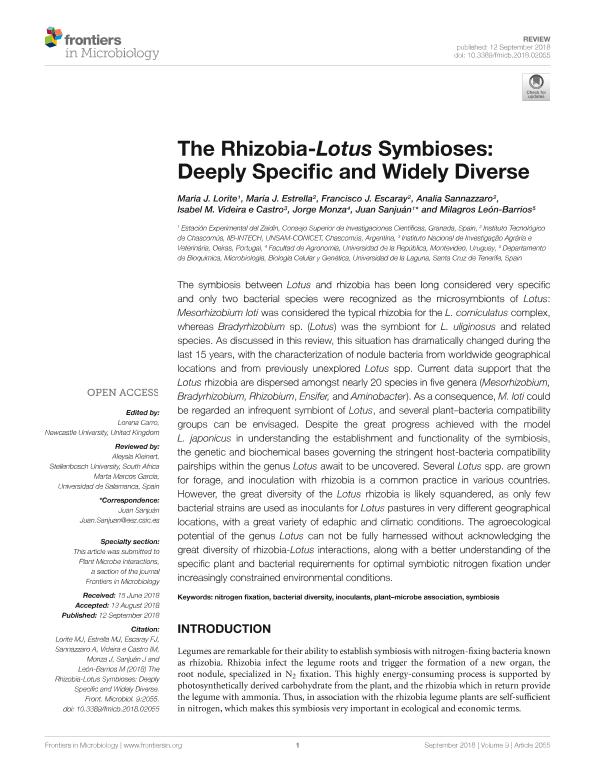Mostrar el registro sencillo del ítem
dc.contributor.author
Lorite, María J.
dc.contributor.author
Estrella, María J.
dc.contributor.author
Escaray, Francisco José

dc.contributor.author
Sannazzaro, Analía Inés

dc.contributor.author
Videira e Castro, Isabel M.
dc.contributor.author
Monza, Jorge
dc.contributor.author
Sanjuán, Juan
dc.contributor.author
León Barrios, Milagros
dc.date.available
2019-09-23T20:59:55Z
dc.date.issued
2018-09
dc.identifier.citation
Lorite, María J.; Estrella, María J.; Escaray, Francisco José; Sannazzaro, Analía Inés; Videira e Castro, Isabel M.; et al.; The Rhizobia-Lotus symbioses: Deeply specific and widely diverse; Frontiers Media S.A.; Frontiers in Microbiology; 9; SEP; 9-2018; 1-17
dc.identifier.issn
1664-302X
dc.identifier.uri
http://hdl.handle.net/11336/84221
dc.description.abstract
The symbiosis between Lotus and rhizobia has been long considered very specific and only two bacterial species were recognized as the microsymbionts of Lotus: Mesorhizobium loti was considered the typical rhizobia for the L. Corniculatus complex, whereas Bradyrhizobium sp. (Lotus) was the symbiont for L. Uliginosus and related species. As discussed in this review, this situation has dramatically changed during the last 15 years, with the characterization of nodule bacteria from worldwide geographical locations and from previously unexplored Lotus spp. Current data support that the Lotus rhizobia are dispersed amongst nearly 20 species in five genera (Mesorhizobium, Bradyrhizobium, Rhizobium, Ensifer, and Aminobacter). As a consequence, M. Loti could be regarded an infrequent symbiont of Lotus, and several plant-bacteria compatibility groups can be envisaged. Despite the great progress achieved with the model L. Japonicus in understanding the establishment and functionality of the symbiosis, the genetic and biochemical bases governing the stringent host-bacteria compatibility pairships within the genus Lotus await to be uncovered. Several Lotus spp. Are grown for forage, and inoculation with rhizobia is a common practice in various countries. However, the great diversity of the Lotus rhizobia is likely squandered, as only few bacterial strains are used as inoculants for Lotus pastures in very different geographical locations, with a great variety of edaphic and climatic conditions. The agroecological potential of the genus Lotus can not be fully harnessed without acknowledging the great diversity of rhizobia-Lotus interactions, along with a better understanding of the specific plant and bacterial requirements for optimal symbiotic nitrogen fixation under increasingly constrained environmental conditions.
dc.format
application/pdf
dc.language.iso
eng
dc.publisher
Frontiers Media S.A.
dc.rights
info:eu-repo/semantics/openAccess
dc.rights.uri
https://creativecommons.org/licenses/by/2.5/ar/
dc.subject
Bacterial Diversity
dc.subject
Inoculants
dc.subject
Nitrogen Fixation
dc.subject
Plant-Microbe Association
dc.subject
Symbiosis
dc.subject.classification
Biología Celular, Microbiología

dc.subject.classification
Ciencias Biológicas

dc.subject.classification
CIENCIAS NATURALES Y EXACTAS

dc.title
The Rhizobia-Lotus symbioses: Deeply specific and widely diverse
dc.type
info:eu-repo/semantics/article
dc.type
info:ar-repo/semantics/artículo
dc.type
info:eu-repo/semantics/publishedVersion
dc.date.updated
2019-09-12T17:27:21Z
dc.journal.volume
9
dc.journal.number
SEP
dc.journal.pagination
1-17
dc.journal.pais
Suiza

dc.journal.ciudad
Lausana
dc.description.fil
Fil: Lorite, María J.. Consejo Superior de Investigaciones Científicas. Estación Experimental del Zaidín; España
dc.description.fil
Fil: Estrella, María J.. Consejo Nacional de Investigaciones Científicas y Técnicas. Centro Científico Tecnológico Conicet - La Plata. Instituto de Investigaciones Biotecnológicas. Instituto de Investigaciones Biotecnológicas "Dr. Raúl Alfonsín" (sede Chascomús). Universidad Nacional de San Martín. Instituto de Investigaciones Biotecnológicas. Instituto de Investigaciones Biotecnológicas "Dr. Raúl Alfonsín" (sede Chascomús); Argentina
dc.description.fil
Fil: Escaray, Francisco José. Consejo Nacional de Investigaciones Científicas y Técnicas. Centro Científico Tecnológico Conicet - La Plata. Instituto de Investigaciones Biotecnológicas. Instituto de Investigaciones Biotecnológicas "Dr. Raúl Alfonsín" (sede Chascomús). Universidad Nacional de San Martín. Instituto de Investigaciones Biotecnológicas. Instituto de Investigaciones Biotecnológicas "Dr. Raúl Alfonsín" (sede Chascomús); Argentina
dc.description.fil
Fil: Sannazzaro, Analía Inés. Consejo Nacional de Investigaciones Científicas y Técnicas. Centro Científico Tecnológico Conicet - La Plata. Instituto de Investigaciones Biotecnológicas. Instituto de Investigaciones Biotecnológicas "Dr. Raúl Alfonsín" (sede Chascomús). Universidad Nacional de San Martín. Instituto de Investigaciones Biotecnológicas. Instituto de Investigaciones Biotecnológicas "Dr. Raúl Alfonsín" (sede Chascomús); Argentina
dc.description.fil
Fil: Videira e Castro, Isabel M.. Instituto Nacional de Investigação Agrária e Veterinária; Portugal
dc.description.fil
Fil: Monza, Jorge. Universidad de la República; Uruguay
dc.description.fil
Fil: Sanjuán, Juan. Consejo Superior de Investigaciones Científicas. Estación Experimental del Zaidín; España
dc.description.fil
Fil: León Barrios, Milagros. Universidad de La Laguna; España
dc.journal.title
Frontiers in Microbiology
dc.relation.alternativeid
info:eu-repo/semantics/altIdentifier/doi/http://dx.doi.org/10.3389/fmicb.2018.02055
dc.relation.alternativeid
info:eu-repo/semantics/altIdentifier/url/https://www.frontiersin.org/articles/10.3389/fmicb.2018.02055/full
Archivos asociados
